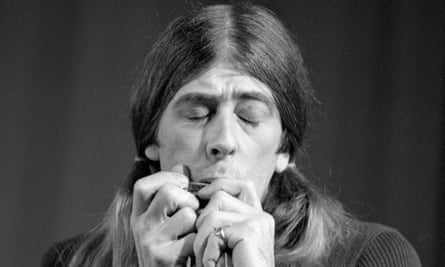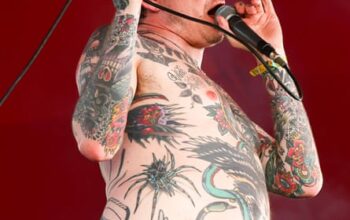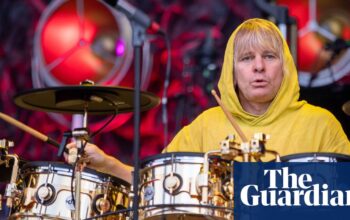John Mayall, the linchpin of the British blues scene who gave a platform to some of the 20th century’s greatest rock musicians including Eric Clapton and members of Fleetwood Mac, has died aged 90.
A statement on Mayall’s Instagram page announced his death, saying the musician died on Monday at his home in California. “Health issues that forced John to end his epic touring career have finally led to peace for one of this world’s greatest road warriors,” the post said.
Mayall was born in Macclesfield in 1933. He began investigating his father’s jazz and blues collection as a teenager, and learned to play piano, guitar and harmonica to create his own take on the music. Following three years of national service that took him to Korea, he went to art school and became a graphic designer, with music on the side via the band Blues Syndicate.
He also lived in a tree house in his parents’ garden – “When I was a teenager, right up to the time I got married, when I was 30,” he later said. “We lived in a small house, so, my room was up a tree.”
In 1963, aged 30, he moved to London to become a professional musician, amid the rhythm and blues boom that birthed bands including the Rolling Stones, the Spencer Davis Group and the Animals.

“The scene in America was racially segregated – over there, never the twain would meet,” he explained to the Guardian in 2014. “In Europe, however – not just England – the black blues began to be heard by an audience that was not listening to them in America. We discovered Elmore James, Freddie King, JB Lenoir, and they spoke to our feelings, our life stories and that was it. Hooked.”
Singing as well as playing guitar and keys, Mayall recruited musicians including John McVie (who would go on to form Fleetwood Mac) for the earliest incarnation of his ever-evolving band the Bluesbreakers. They released their debut single in 1964, and were the backing band for John Lee Hooker the same year. Mayall also played with touring blues greats including Sonny Boy Williamson and T-Bone Walker in this period, and used his own band evangelistically to bring the blues to wider attention in the UK, playing both cover versions and original material.
Amid a constantly rotating lineup, Eric Clapton joined the Bluesbreakers in 1965 after leaving the Yardbirds, and the first sessions with him were produced by a young Jimmy Page (who soon joined the Yardbirds, before forming Led Zeppelin).
Clapton’s place was then briefly taken by another future Fleetwood Mac star, Peter Green, and Jack Bruce played bass for a time. After Clapton returned, the group recorded their first hit album, 1966’s Blues Breakers With Eric Clapton.
Clapton left shortly after to form Cream – “He was always kind of restless so it wasn’t really that big of a surprise,” Mayall later said – and Green returned, with the Bluesbreakers also briefly including another Fleetwood Mac co-founder, drummer Mick Fleetwood. After Green left permanently, Mayall hired a 17-year-old Mick Taylor, who played with the band before replacing Brian Jones in the Rolling Stones. The Bluesbreakers had three further UK Top 10 albums in this period, including the No 3 hit Bare Wires.
It was to be the Bluesbreakers’ last album for 17 years – Mayall dropped the name after Taylor’s departure, and moved to California in 1969 where he spent the whole of the 1970s. To surprise in the blues-rock scene, he shifted away from the driving and noisy music he’d been making in the UK, and towards recordings without a drummer and with acoustic instrumentation such as woodwind, saxophone and fingerpicked guitar – though he revisited his louder, raunchier style on 1971 double album Back to the Roots, with Clapton and Taylor guesting.
The 70s saw him stretch out further, touching on jazz and funk in various US outfits. He reunited with Taylor, McVie and drummer Colin Allen in 1982, and while that lineup didn’t last, Mayall kept the Bluesbreakers name going for numerous further albums. Guests along the way included Mavis Staples, Buddy Guy and old touring partner John Lee Hooker. Along For the Ride, in 2001, featured numerous starry former Bluesbreakers among its 20 guests, plus Steve Miller, Chris Rea, Billy Gibbons of ZZ Top, and more.
In 2008, he permanently retired the Bluesbreakers name to free himself up to play with other musicians, including the hiring of his first female lead guitarist, Carolyn Wonderland, in 2018. He played hundreds of live concerts each year, and continued touring until 2022.
Mayall had four children with his first wife Pamela: Gary, Jason and Tracey, plus adopted son Benedict. In 1978, Mayall met blues musician Maggie Parker, who was more than 20 years his junior – she joined his backing band and they later married. They had two sons but divorced in 2011.
In 1979, their Laurel Canyon house burned down and was later rebuilt, with Maggie later writing: “We escaped with our lives and nothing but the clothes on our backs … John dropped the garden hose and we ran like hell, driving through flames in our friend’s Chevy Suburban.”
Mayall is due to be inducted in the Rock and Roll Hall of Fame later this year, given the Musical Influence award alongside two other icons of the blues, Big Mama Thornton and Alexis Korner.
Artists paying tribute to Mayall included Joe Bonamassa, who wrote: “Rest in peace my friend”.
Source: theguardian.com


